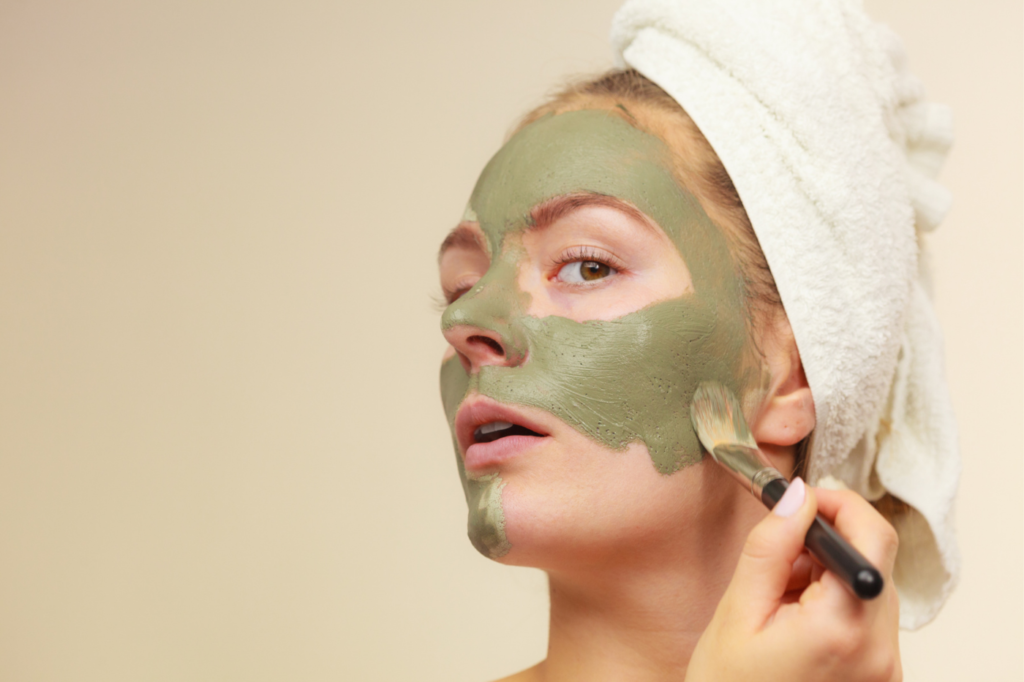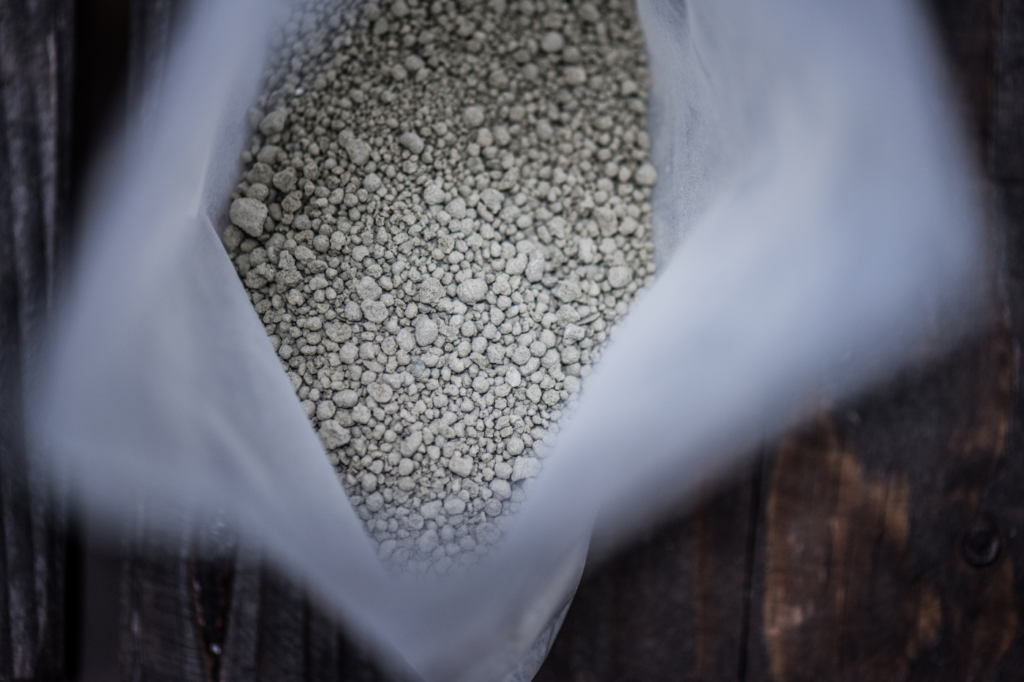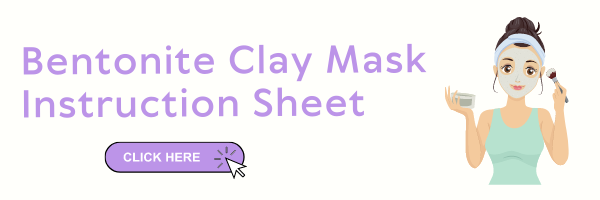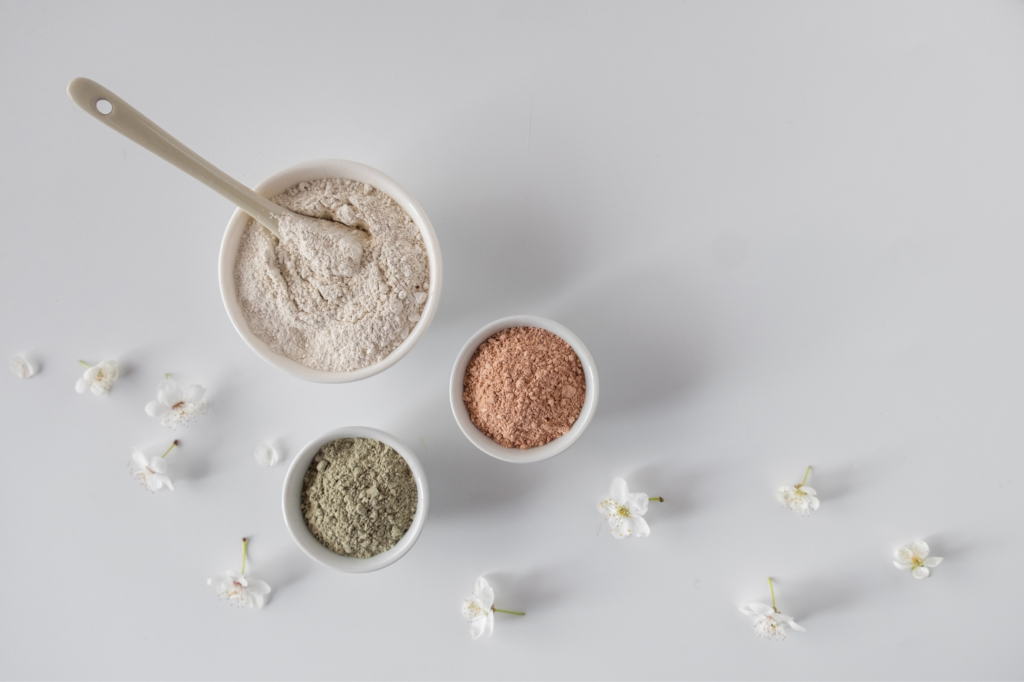A bentonite clay mask is one of my most recommended natural remedies for problem skin at a fraction of the cost of most traditional skin treatments.
Like an Instagram filter, it’s low effort and high results. When a dermatologist is recommending a DIY face mask option, you know it’s good!
What is bentonite clay, and why should you use it? Bentonite clay is an absorbent clay made from volcanic ash. It’s named after Fort Benton in the United States. This region of Montana and Wyoming is where the largest known deposit of bentonite clay is found.
That leads us to another obvious query: how is it used? Bentonite clay can be blended with apple cider vinegar or warm water to create a thick paste, applied to the skin. It’s that simple: mix a few ingredients; relax. While you wait, it will work its magic (or science). What’s not to love?
How does bentonite clay work for skin?
Bentonite clay is slightly electrically charged, or has a high cation exchange capacity. The clay’s negative charge allows it to pick up positively charged ions, like metals.
Bentonite clay is also highly absorbent, making it possible to pick up oils and impurities on the skin. Essentially, bentonite clay whisks away potential clogging agents and toxins in order to leave tighter, cleaner skin in its wake.
 How to Use Bentonite Clay Face Masks
How to Use Bentonite Clay Face Masks
Bentonite clay face masks are extremely user-friendly, but here are the best practices to get the most out of your mask:
What can I mix with bentonite clay?
Bentonite clay typically comes as a fine powder, so you’ll need to mix in some moisture to create a mask.
As a precaution, you will want to use purified water, not simply from the tap, or organic apple cider vinegar. No extra additives here!
How do I apply it?
Start with a freshly cleansed face, gently patted dry.
Smooth the clay over the skin in a gentle motion, working upwards and outwards from the center of the face and avoiding the eye area. You can use your hands or a facial cream spatula applicator; either is appropriate.
Ideally, you will have a thick, even layer across the whole face.
How long do you leave bentonite clay on your face?
Leave the clay on until dry, typically about 10 minutes, and then remove it with a wet washcloth.
How often can I use bentonite clay?
I typically recommend using this mask in conjunction with a manuka honey mask, depending on skin type. Bentonite clay masks are generally more suited for oily skin, while manuka honey is a bit more hydrating for dry skin.
Masks should be used once a week. For those with combination skin, you can alternate between these two skin care products based on the condition of your skin each week.
4 DIY Bentonite Clay Mask Recipes
Bentonite clay masks can be used to treat a variety of skin conditions and problems. Here are some of my favorite DIY recipes:
Armpit Detox Mask
- 1 tablespoon of bentonite clay powder
- 1 tablespoon of apple cider vinegar
To banish body odor, this is a great option. Particularly if you’re switching to a natural deodorant, it’s wise to detoxify the armpits first to prevent smells, irritation, or excess sweat during the transition.
Simply mix these 2 elements together and then leave on for 5 minutes, building up to 10 minutes over the course of a few days. Repeat until the armpits are adjusted to the natural deodorant.
Soothing Yogurt Bentonite Clay Facial Mask
- 2 tablespoons of plain organic yogurt
- 2 tablespoons of bentonite clay powder
This is a great option for more sensitive skin.
Mix these 2 ingredients together thoroughly, then apply to the face as described above. Wait 15 minutes for the mask to fully dry, then remove with a warm washcloth.
Tightening Aloe Vera, Honey, and Clay Mask
- 2 tablespoons of manuka honey
- 2 tablespoons of bentonite clay powder
- 2 tablespoons of organic aloe vera gel
For oily or acne-scarred skin, this mask can restore tightness and bring soothing, healing properties.
Simply mix all 3 ingredients and then apply to the face. This mask will be a bit less thick and lighter on the skin than other recipes listed here.
Breakout Banishing Acne Mask
- 3 tablespoons of bentonite clay
- 2 tablespoons distilled water
- ½ teaspoon of apple cider vinegar
- 3 drops of tea tree essential oil
Mix the clay and water together until a smooth paste forms. Next, mix in the apple cider vinegar and tea tree oil. Apply to face and back or chest, wherever problem areas arise.
Bonus: Bentonite Clay Cleanser
- 4 ounces organic coconut oil (warmed to a liquid state)
- 1 ounce bentonite clay powder
- 3 drops of either lavender or frankincense essential oil
Place the ingredients into a glass jar with a lid, then shake well to blend. Refrigerate until a creamy consistency, checking for clay that may settle on the bottom.
Use regularly around the face to protect and nourish the skin.
Note: this cleanser may not be appropriate for acne-prone skin. Check your skin’s reaction to coconut oil (or any natural oil) before using regularly, as it can clog pores in some cases.
Benefits of Bentonite Clay Masks
Bentonite clay masks have many positive qualities that can impact the skin. Whether it’s acne or a rash, there’s a solution to be found in bentonite clay. Here are some of the science-backed benefits.
Absorbent
If you’re struggling with pimples and acne breakouts, bentonite clay can help to draw out and absorb sebum, dirt, and impurities. The clay mask soaks up excess oil sitting on the surface of the skin, one of the leading causes of blemishes.
Goodbye, acne woes!
The natural negative charge of bentonite clay allows it to draw out and remove heavy metals, pulling harmful agents from beneath the skin’s surface. These absorbent abilities help to detoxify the skin. This clay even removes dead skin cells, allowing a glow to shine through.
Anti-Inflammatory & Antibacterial
Bentonite clay is anti-inflammatory and has been recognized as an effective agent in tackling poison ivy and poison oak allergic reactions. These inflammation-fighting properties may reduce the length and severity of the allergic reactions, soothing the itch and removing the rash more quickly.
The antibacterial qualities of bentonite clay powder can also help to quell acne flare-ups and reduce bacteria-causing acne on the skin, such as Cutibacterium acnes.
Healing
Amazingly, not only does bentonite clay even expedite healing for skin lesions, but it can also create a skin barrier against potential irritants. This means that it will heal current skin issues while also protecting the skin from future inflammation and reactions.
Risks & Precautions
While bentonite clay use is easy, over the counter, and relatively risk-free, there are some precautions and risks you should be aware of:
- One concern is easy to find on Google: Does bentonite clay lighten skin? Yes, bentonite clay can lighten dark spots and acne scarring, but it can also be used for skin lightening. However, I don’t recommend that because of the way it dries the skin — one reason it’s vital to use a great moisturizer. Know that if you overuse bentonite clay, your skin may lighten.
- What are the side effects of bentonite clay? The external side effects of bentonite clay are relatively few. They include dry skin from overuse and possible danger to women and children after large internal doses.
- One precaution for making masks: it is important to note that due to bentonite clay’s ability to absorb metals, you should not use a metal mixing bowl or spoon to create these masks.
As you can see, the risks and precautions associated with this skincare product are minimal. The choice is clear: when it comes to a bentonite clay mask, the benefits and options of how to use it make it an easy choice.
Sources
- Moosavi, M. (2017). Bentonite Clay as a Natural Remedy: a brief review. Iranian journal of public health, 46(9), 1176. Full text: https://www.ncbi.nlm.nih.gov/pmc/articles/PMC5632318/
- Marks Jr, J. G., Fowler Jr, J. F., Sherertz, E. F., & Rietschel, R. L. (1995). Prevention of poison ivy and poison oak allergic contact dermatitis by quaternium-18 bentonite. Journal of the American Academy of Dermatology, 33(2), 212-216. Abstract: https://pubmed.ncbi.nlm.nih.gov/7622647/
- Haydel, S. E., Remenih, C. M., & Williams, L. B. (2008). Broad-spectrum in vitro antibacterial activities of clay minerals against antibiotic-susceptible and antibiotic-resistant bacterial pathogens. Journal of Antimicrobial Chemotherapy, 61(2), 353-361. Abstract: https://pubmed.ncbi.nlm.nih.gov/18070832/
- Platsidaki, E., & Dessinioti, C. (2018). Recent advances in understanding Propionibacterium acnes (Cutibacterium acnes) in acne. F1000Research, 7. Full text: https://www.ncbi.nlm.nih.gov/pmc/articles/PMC6305227/
- Sandri, G., Bonferoni, M. C., Ferrari, F., Rossi, S., Aguzzi, C., Mori, M., … & Caramella, C. (2014). Montmorillonite–chitosan–silver sulfadiazine nanocomposites for topical treatment of chronic skin lesions: in vitro biocompatibility, antibacterial efficacy and gap closure cell motility properties. Carbohydrate polymers, 102, 970-977. Abstract: https://pubmed.ncbi.nlm.nih.gov/24507371/
- Bennett, A., & Stryjewski, G. (2006). Severe hypokalemia caused by oral and rectal administration of bentonite in a pediatric patient. Pediatric emergency care, 22(7), 500-502. Abstract: https://pubmed.ncbi.nlm.nih.gov/16871112/


 How to Use Bentonite Clay Face Masks
How to Use Bentonite Clay Face Masks

